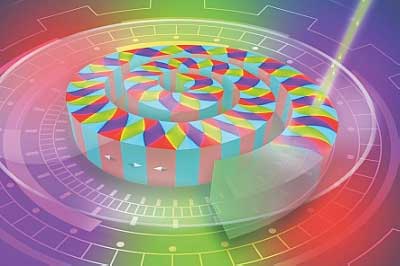| Nov 12, 2019 | |
Magnetic tuning at the nanoscale(Nanowerk News) In collaboration with colleagues from the Leibniz Institute for Solid State and Materials Research Dresden (IFW) and the University of Glasgow, physicists from the German research center Helmholtz-Zentrum Dresden-Rossendorf (HZDR) are working to produce engineered magnetic nanostructures and to tailor material properties at the nanoscale. |
|
| The scientists use a special microscope at the HZDR Ion Beam Center to achieve this goal. This microscope's ultrathin ion beam is capable of producing stable, periodically arranged nanomagnets in a sample material. The device can also be used to optimize the magnetic properties of carbon nanotubes. | |
| The researchers report their findings in two articles that have been published in Small ("Strain Anisotropy and Magnetic Domains in Embedded Nanomagnets" and "Magnetization Dynamics of an Individual Single-Crystalline Fe-Filled Carbon Nanotube"). | |
| "The magnetic tuning of materials in the nanometer range offers great potential for the production of state-of-the-art electronic components. We pursue various approaches with regard to our magnetic nanostructures, all of which involve the use of ion beams," stated HZDR researchers Dr. Rantej Bali, Dr. Kilian Lenz and Dr. Gregor Hlawacek. | |
| If, for example, an ion beam is directed at a non-ferromagnetic iron-aluminum alloy, it can displace a few hundred atoms. The atoms in the alloy then rearrange, thereby increasing the number of adjacent magnetic iron atoms. As a result a magnet is formed within the vicinity of the bombardment site. This approach enabled the researchers to engrave nanomagnets locally in thin films of a material that was originally non-ferromagnetic. | |
 |
|
| The ion beam acts like a magnetic stylus for generating spiral-shaped nanomagets, for instance. (Image: HZDR / Sahneweiß / Freepik) | |
Disorder induces the incorporation of nanomagnets |
|
| In their latest work, the HZDR scientists demonstrate that the ion-beam-induced disorder also increases the volume of the underlying lattice structure, albeit not evenly in all spatial directions. The lattice distortion also affects the magnetic behaviour. | |
| For instance, in an elongated magnetic stripe, the magnetization is expected to align along the long axis - as is typically the case in a conventional bar magnet. Because of the lattice distortion in the embedded nanomagnets however, transverse magnetization components are also observed. The net effect is that the magnetic moments tend to "bend" away from the magnet's length in a periodic fashion. | |
| These stable, periodic magnetic domains can be reliably formed in curved magnets as well, and may find applications in miniaturized magnetic sensors, for instance. | |
| In the HZDR helium-ion microscope, the physicists used noble gases to produce extremely thin - and therefore highly precise - ion beams. "The diameter of our ion beam is just a few atoms wide," explained Gregor Hlawacek, who coordinates the experiments at the helium-ion microscope. "Depending on which noble gas is used, we can then modify the properties of the irradiated material or change its morphology by removing atoms." | |
| Despite its name, the helium-ion microscope is not only limited to the use of helium. In their latest experiments, the researchers used neon, which is heavier than helium, and therefore has a stronger impact on the material to be modified. Cooperation with the University of Glasgow also enabled the HZDR scientists to use the transmission-electron microscope located at its Chair of Material and Condensed Matter Physics. | |
| Rantej Bali's experiments involved using a neon ion beam as a magnetic writing stylus: "The ion beam enables magnetic nanostructures to be produced in any shape or form, which are embedded in the material and defined solely by their magnetic and crystallographic properties," stated Bali, summarizing the results of his previous research, conducted at the HZDR within a DFG project. | |
Using neon ions to trim materials |
|
| Kilian Lenz, on the other hand, uses the method of focused ion beam manipulation to optimize desirable material properties by changing the geometry of the nanostructure itself. The neon ion beam used has a diameter of just two nanometers. At the bombardment site, unevenness in the material, or simply material edges, are removed in equal dimension. | |
| "We examine this using carbon nanotubes containing an almost cylindrical magnetic iron core. The structure and geometry of these nanotubes can be optimized by trimming in the helium-ion microscope," stated Lenz, describing the process. | |
| A micro-manipulator is used to separate a single tube - with a diameter of 70 nanometers and a length of 10 micrometers - and to place it in a microresonator for measurement. | |
| "It is an extremely elaborate process that the team from the Leibniz Institute for Solid State and Materials Research Dresden has developed for us," explained Lenz. | |
| The unique combination of cuts using the focused ion beam and measurements of the ferromagnetic resonance of the iron core enables the researchers, led by Lenz, to shed light on a nearly perfect magnetic structure to unveil the properties of the iron core in the nanotube. | |
| s Such methods for the targeted manipulation of nanomagnetic material properties using focussed ion beams will continue to be explored at the HZDR's Institute of Ion Beam Physics and Materials Research in the future. The scientists believe that their method and the tuned materials it produces have the potential for achieving progress in spintronic applications and in the fabrication of innovative sensing devices or storage media. |
| Source: Helmholtz-Zentrum Dresden-Rossendorf | |
|
Subscribe to a free copy of one of our daily Nanowerk Newsletter Email Digests with a compilation of all of the day's news. |
